Analysis of Sustainable and Responsible Tourism in Norway: A Report
VerifiedAdded on 2022/12/15
|20
|5873
|399
Report
AI Summary
This report provides a comprehensive analysis of sustainable and responsible tourism in Norway, covering its historical evolution from the 1980s to the present day. It defines the concept and examines the major developments in sustainable tourism within Norway, including the role of Destination Management Organizations (DMOs) and green tourism initiatives. The report identifies and analyzes the roles, functions, and missions of leading global enterprises such as UNWTO and PATA in promoting sustainable tourism worldwide. It explores the purpose and principles of tourism development and planning in Norway, aiming to minimize adverse effects, and evaluates the processes involved, along with associated challenges. Furthermore, the report investigates the impacts of tourism activities on Norway from social, economic, and cultural perspectives. It analyzes the implementation of sustainability principles to meet stakeholder expectations and evaluates the ways in which sustainability is managed and developed by tourism organizations in Norway. The report concludes by summarizing the key findings and offering insights into the future of sustainable tourism in Norway.
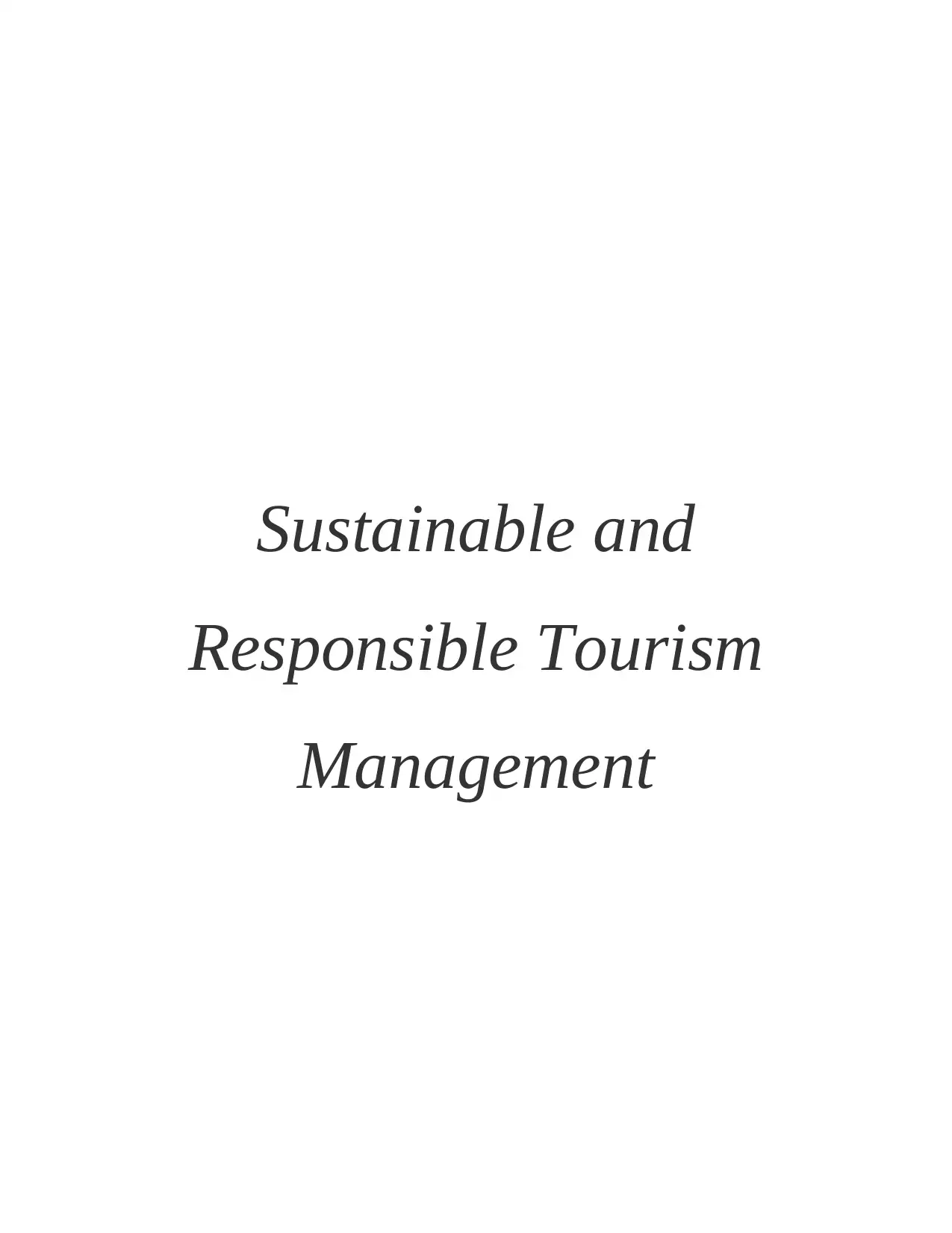
Sustainable and
Responsible Tourism
Management
Responsible Tourism
Management
Paraphrase This Document
Need a fresh take? Get an instant paraphrase of this document with our AI Paraphraser

Table of Contents
INTRODUCTION...........................................................................................................................1
TASK 1............................................................................................................................................1
P1 Explanation of how concept of sustainable and responsible tourism have evolved with time
.....................................................................................................................................................1
P2. Determining major the role, function and mission of leading global enterprise which
involved in promotion of sustainable, responsible tourism.........................................................2
TASK 2............................................................................................................................................4
P3. Explore the purpose and principles of tourism development, planning to reduce adverse
effects of tourism.........................................................................................................................4
P4. Evaluate the different process of tourism development, planning and associated with
significant challenges, problems in destination place..................................................................5
TASK 3............................................................................................................................................6
Understand the impacts of tourism activity generated by a specific tourism attraction from
social, economic and cultural aspects..........................................................................................7
P6. Examine the suitable principles of sustainability implemented by tourism destination to
meet stakeholder expectations, requirements..............................................................................8
TASK 4............................................................................................................................................9
P7. Evaluation of the ways in which sustainability is managed or developed by tourism
organization.................................................................................................................................9
CONCLUSION..............................................................................................................................10
REFERENCES..............................................................................................................................11
INTRODUCTION...........................................................................................................................1
TASK 1............................................................................................................................................1
P1 Explanation of how concept of sustainable and responsible tourism have evolved with time
.....................................................................................................................................................1
P2. Determining major the role, function and mission of leading global enterprise which
involved in promotion of sustainable, responsible tourism.........................................................2
TASK 2............................................................................................................................................4
P3. Explore the purpose and principles of tourism development, planning to reduce adverse
effects of tourism.........................................................................................................................4
P4. Evaluate the different process of tourism development, planning and associated with
significant challenges, problems in destination place..................................................................5
TASK 3............................................................................................................................................6
Understand the impacts of tourism activity generated by a specific tourism attraction from
social, economic and cultural aspects..........................................................................................7
P6. Examine the suitable principles of sustainability implemented by tourism destination to
meet stakeholder expectations, requirements..............................................................................8
TASK 4............................................................................................................................................9
P7. Evaluation of the ways in which sustainability is managed or developed by tourism
organization.................................................................................................................................9
CONCLUSION..............................................................................................................................10
REFERENCES..............................................................................................................................11

⊘ This is a preview!⊘
Do you want full access?
Subscribe today to unlock all pages.

Trusted by 1+ million students worldwide
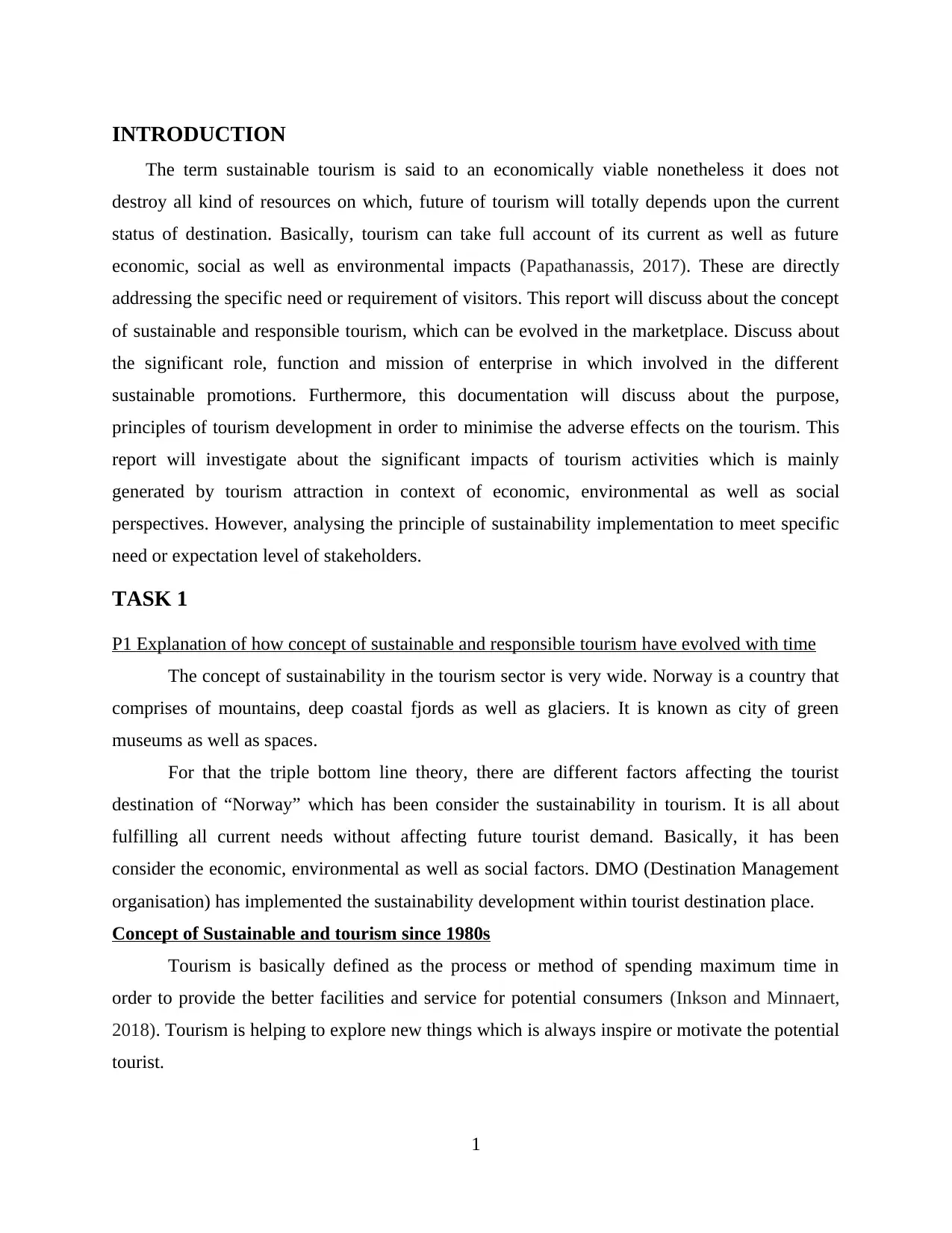
INTRODUCTION
The term sustainable tourism is said to an economically viable nonetheless it does not
destroy all kind of resources on which, future of tourism will totally depends upon the current
status of destination. Basically, tourism can take full account of its current as well as future
economic, social as well as environmental impacts (Papathanassis, 2017). These are directly
addressing the specific need or requirement of visitors. This report will discuss about the concept
of sustainable and responsible tourism, which can be evolved in the marketplace. Discuss about
the significant role, function and mission of enterprise in which involved in the different
sustainable promotions. Furthermore, this documentation will discuss about the purpose,
principles of tourism development in order to minimise the adverse effects on the tourism. This
report will investigate about the significant impacts of tourism activities which is mainly
generated by tourism attraction in context of economic, environmental as well as social
perspectives. However, analysing the principle of sustainability implementation to meet specific
need or expectation level of stakeholders.
TASK 1
P1 Explanation of how concept of sustainable and responsible tourism have evolved with time
The concept of sustainability in the tourism sector is very wide. Norway is a country that
comprises of mountains, deep coastal fjords as well as glaciers. It is known as city of green
museums as well as spaces.
For that the triple bottom line theory, there are different factors affecting the tourist
destination of “Norway” which has been consider the sustainability in tourism. It is all about
fulfilling all current needs without affecting future tourist demand. Basically, it has been
consider the economic, environmental as well as social factors. DMO (Destination Management
organisation) has implemented the sustainability development within tourist destination place.
Concept of Sustainable and tourism since 1980s
Tourism is basically defined as the process or method of spending maximum time in
order to provide the better facilities and service for potential consumers (Inkson and Minnaert,
2018). Tourism is helping to explore new things which is always inspire or motivate the potential
tourist.
1
The term sustainable tourism is said to an economically viable nonetheless it does not
destroy all kind of resources on which, future of tourism will totally depends upon the current
status of destination. Basically, tourism can take full account of its current as well as future
economic, social as well as environmental impacts (Papathanassis, 2017). These are directly
addressing the specific need or requirement of visitors. This report will discuss about the concept
of sustainable and responsible tourism, which can be evolved in the marketplace. Discuss about
the significant role, function and mission of enterprise in which involved in the different
sustainable promotions. Furthermore, this documentation will discuss about the purpose,
principles of tourism development in order to minimise the adverse effects on the tourism. This
report will investigate about the significant impacts of tourism activities which is mainly
generated by tourism attraction in context of economic, environmental as well as social
perspectives. However, analysing the principle of sustainability implementation to meet specific
need or expectation level of stakeholders.
TASK 1
P1 Explanation of how concept of sustainable and responsible tourism have evolved with time
The concept of sustainability in the tourism sector is very wide. Norway is a country that
comprises of mountains, deep coastal fjords as well as glaciers. It is known as city of green
museums as well as spaces.
For that the triple bottom line theory, there are different factors affecting the tourist
destination of “Norway” which has been consider the sustainability in tourism. It is all about
fulfilling all current needs without affecting future tourist demand. Basically, it has been
consider the economic, environmental as well as social factors. DMO (Destination Management
organisation) has implemented the sustainability development within tourist destination place.
Concept of Sustainable and tourism since 1980s
Tourism is basically defined as the process or method of spending maximum time in
order to provide the better facilities and service for potential consumers (Inkson and Minnaert,
2018). Tourism is helping to explore new things which is always inspire or motivate the potential
tourist.
1
Paraphrase This Document
Need a fresh take? Get an instant paraphrase of this document with our AI Paraphraser
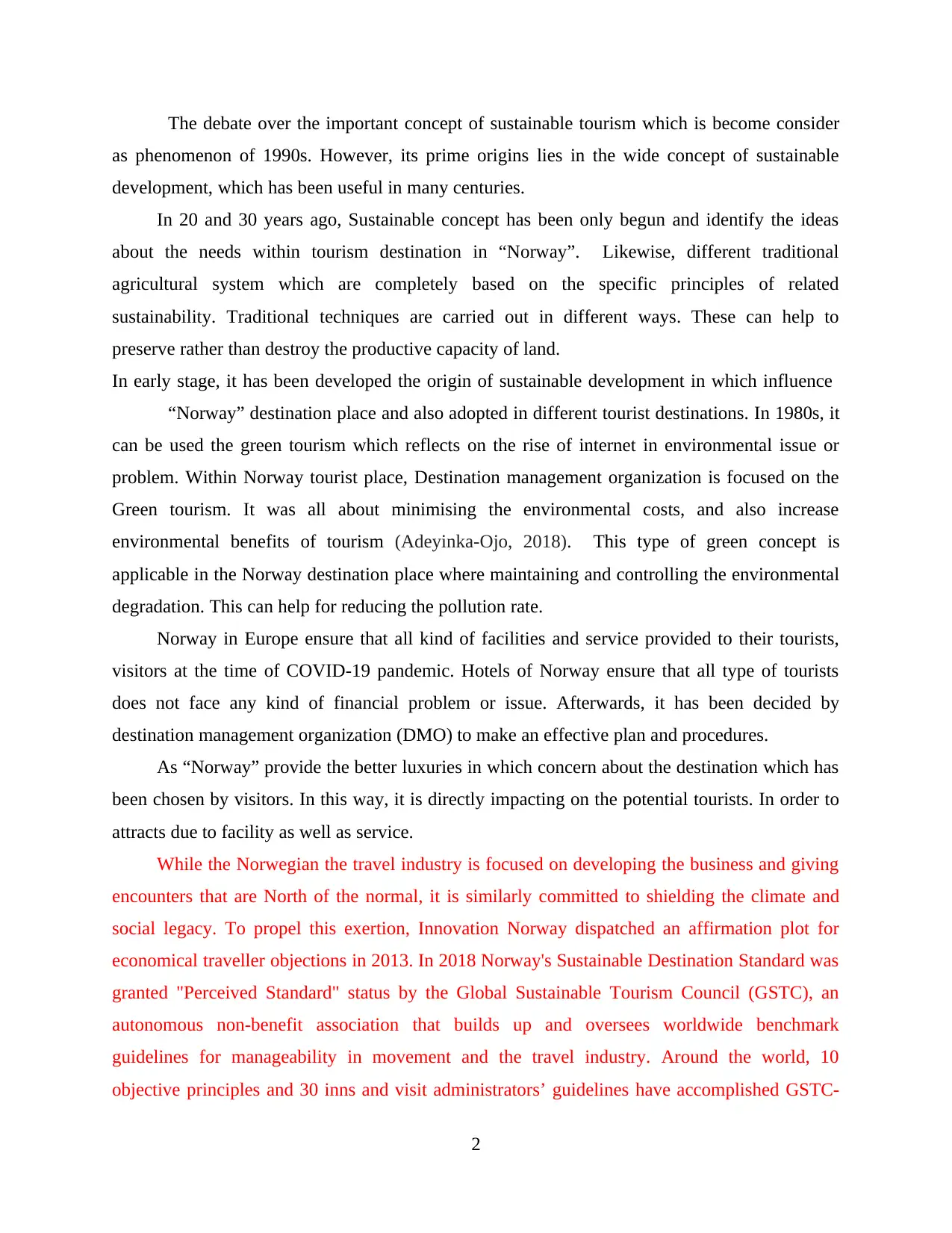
The debate over the important concept of sustainable tourism which is become consider
as phenomenon of 1990s. However, its prime origins lies in the wide concept of sustainable
development, which has been useful in many centuries.
In 20 and 30 years ago, Sustainable concept has been only begun and identify the ideas
about the needs within tourism destination in “Norway”. Likewise, different traditional
agricultural system which are completely based on the specific principles of related
sustainability. Traditional techniques are carried out in different ways. These can help to
preserve rather than destroy the productive capacity of land.
In early stage, it has been developed the origin of sustainable development in which influence
“Norway” destination place and also adopted in different tourist destinations. In 1980s, it
can be used the green tourism which reflects on the rise of internet in environmental issue or
problem. Within Norway tourist place, Destination management organization is focused on the
Green tourism. It was all about minimising the environmental costs, and also increase
environmental benefits of tourism (Adeyinka-Ojo, 2018). This type of green concept is
applicable in the Norway destination place where maintaining and controlling the environmental
degradation. This can help for reducing the pollution rate.
Norway in Europe ensure that all kind of facilities and service provided to their tourists,
visitors at the time of COVID-19 pandemic. Hotels of Norway ensure that all type of tourists
does not face any kind of financial problem or issue. Afterwards, it has been decided by
destination management organization (DMO) to make an effective plan and procedures.
As “Norway” provide the better luxuries in which concern about the destination which has
been chosen by visitors. In this way, it is directly impacting on the potential tourists. In order to
attracts due to facility as well as service.
While the Norwegian the travel industry is focused on developing the business and giving
encounters that are North of the normal, it is similarly committed to shielding the climate and
social legacy. To propel this exertion, Innovation Norway dispatched an affirmation plot for
economical traveller objections in 2013. In 2018 Norway's Sustainable Destination Standard was
granted "Perceived Standard" status by the Global Sustainable Tourism Council (GSTC), an
autonomous non-benefit association that builds up and oversees worldwide benchmark
guidelines for manageability in movement and the travel industry. Around the world, 10
objective principles and 30 inns and visit administrators’ guidelines have accomplished GSTC-
2
as phenomenon of 1990s. However, its prime origins lies in the wide concept of sustainable
development, which has been useful in many centuries.
In 20 and 30 years ago, Sustainable concept has been only begun and identify the ideas
about the needs within tourism destination in “Norway”. Likewise, different traditional
agricultural system which are completely based on the specific principles of related
sustainability. Traditional techniques are carried out in different ways. These can help to
preserve rather than destroy the productive capacity of land.
In early stage, it has been developed the origin of sustainable development in which influence
“Norway” destination place and also adopted in different tourist destinations. In 1980s, it
can be used the green tourism which reflects on the rise of internet in environmental issue or
problem. Within Norway tourist place, Destination management organization is focused on the
Green tourism. It was all about minimising the environmental costs, and also increase
environmental benefits of tourism (Adeyinka-Ojo, 2018). This type of green concept is
applicable in the Norway destination place where maintaining and controlling the environmental
degradation. This can help for reducing the pollution rate.
Norway in Europe ensure that all kind of facilities and service provided to their tourists,
visitors at the time of COVID-19 pandemic. Hotels of Norway ensure that all type of tourists
does not face any kind of financial problem or issue. Afterwards, it has been decided by
destination management organization (DMO) to make an effective plan and procedures.
As “Norway” provide the better luxuries in which concern about the destination which has
been chosen by visitors. In this way, it is directly impacting on the potential tourists. In order to
attracts due to facility as well as service.
While the Norwegian the travel industry is focused on developing the business and giving
encounters that are North of the normal, it is similarly committed to shielding the climate and
social legacy. To propel this exertion, Innovation Norway dispatched an affirmation plot for
economical traveller objections in 2013. In 2018 Norway's Sustainable Destination Standard was
granted "Perceived Standard" status by the Global Sustainable Tourism Council (GSTC), an
autonomous non-benefit association that builds up and oversees worldwide benchmark
guidelines for manageability in movement and the travel industry. Around the world, 10
objective principles and 30 inns and visit administrators’ guidelines have accomplished GSTC-
2
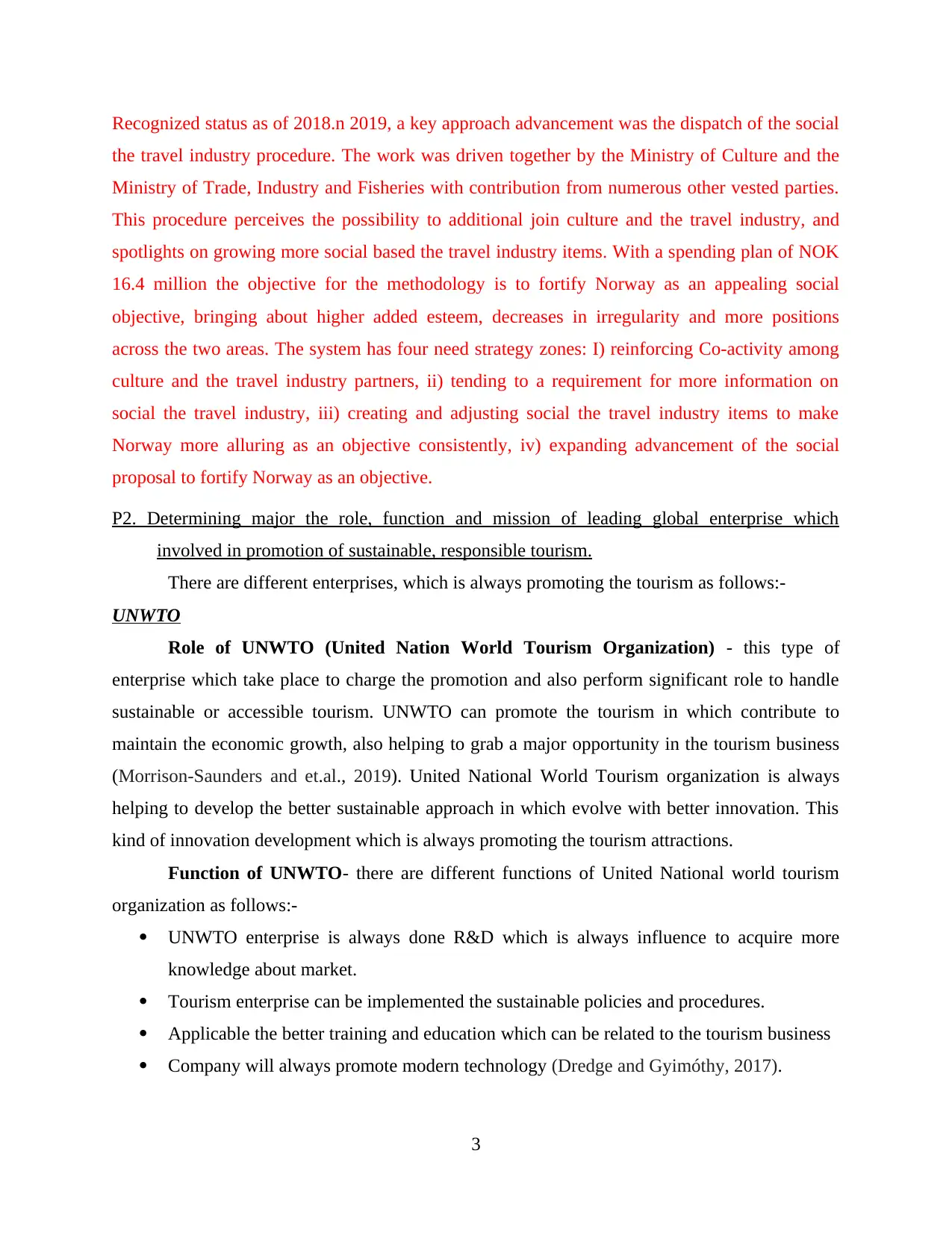
Recognized status as of 2018.n 2019, a key approach advancement was the dispatch of the social
the travel industry procedure. The work was driven together by the Ministry of Culture and the
Ministry of Trade, Industry and Fisheries with contribution from numerous other vested parties.
This procedure perceives the possibility to additional join culture and the travel industry, and
spotlights on growing more social based the travel industry items. With a spending plan of NOK
16.4 million the objective for the methodology is to fortify Norway as an appealing social
objective, bringing about higher added esteem, decreases in irregularity and more positions
across the two areas. The system has four need strategy zones: I) reinforcing Co-activity among
culture and the travel industry partners, ii) tending to a requirement for more information on
social the travel industry, iii) creating and adjusting social the travel industry items to make
Norway more alluring as an objective consistently, iv) expanding advancement of the social
proposal to fortify Norway as an objective.
P2. Determining major the role, function and mission of leading global enterprise which
involved in promotion of sustainable, responsible tourism.
There are different enterprises, which is always promoting the tourism as follows:-
UNWTO
Role of UNWTO (United Nation World Tourism Organization) - this type of
enterprise which take place to charge the promotion and also perform significant role to handle
sustainable or accessible tourism. UNWTO can promote the tourism in which contribute to
maintain the economic growth, also helping to grab a major opportunity in the tourism business
(Morrison-Saunders and et.al., 2019). United National World Tourism organization is always
helping to develop the better sustainable approach in which evolve with better innovation. This
kind of innovation development which is always promoting the tourism attractions.
Function of UNWTO- there are different functions of United National world tourism
organization as follows:-
UNWTO enterprise is always done R&D which is always influence to acquire more
knowledge about market.
Tourism enterprise can be implemented the sustainable policies and procedures.
Applicable the better training and education which can be related to the tourism business
Company will always promote modern technology (Dredge and Gyimóthy, 2017).
3
the travel industry procedure. The work was driven together by the Ministry of Culture and the
Ministry of Trade, Industry and Fisheries with contribution from numerous other vested parties.
This procedure perceives the possibility to additional join culture and the travel industry, and
spotlights on growing more social based the travel industry items. With a spending plan of NOK
16.4 million the objective for the methodology is to fortify Norway as an appealing social
objective, bringing about higher added esteem, decreases in irregularity and more positions
across the two areas. The system has four need strategy zones: I) reinforcing Co-activity among
culture and the travel industry partners, ii) tending to a requirement for more information on
social the travel industry, iii) creating and adjusting social the travel industry items to make
Norway more alluring as an objective consistently, iv) expanding advancement of the social
proposal to fortify Norway as an objective.
P2. Determining major the role, function and mission of leading global enterprise which
involved in promotion of sustainable, responsible tourism.
There are different enterprises, which is always promoting the tourism as follows:-
UNWTO
Role of UNWTO (United Nation World Tourism Organization) - this type of
enterprise which take place to charge the promotion and also perform significant role to handle
sustainable or accessible tourism. UNWTO can promote the tourism in which contribute to
maintain the economic growth, also helping to grab a major opportunity in the tourism business
(Morrison-Saunders and et.al., 2019). United National World Tourism organization is always
helping to develop the better sustainable approach in which evolve with better innovation. This
kind of innovation development which is always promoting the tourism attractions.
Function of UNWTO- there are different functions of United National world tourism
organization as follows:-
UNWTO enterprise is always done R&D which is always influence to acquire more
knowledge about market.
Tourism enterprise can be implemented the sustainable policies and procedures.
Applicable the better training and education which can be related to the tourism business
Company will always promote modern technology (Dredge and Gyimóthy, 2017).
3
⊘ This is a preview!⊘
Do you want full access?
Subscribe today to unlock all pages.

Trusted by 1+ million students worldwide
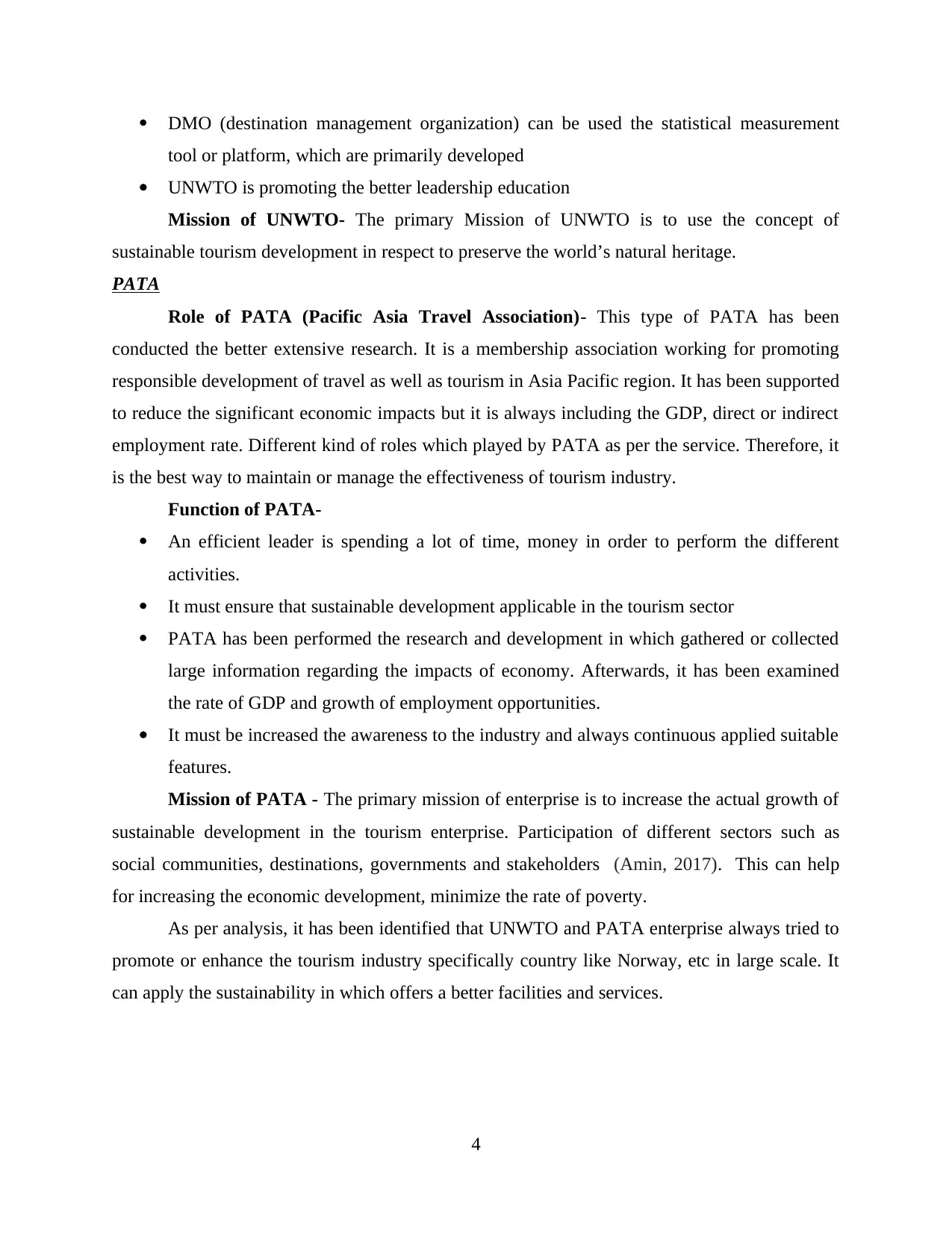
DMO (destination management organization) can be used the statistical measurement
tool or platform, which are primarily developed
UNWTO is promoting the better leadership education
Mission of UNWTO- The primary Mission of UNWTO is to use the concept of
sustainable tourism development in respect to preserve the world’s natural heritage.
PATA
Role of PATA (Pacific Asia Travel Association)- This type of PATA has been
conducted the better extensive research. It is a membership association working for promoting
responsible development of travel as well as tourism in Asia Pacific region. It has been supported
to reduce the significant economic impacts but it is always including the GDP, direct or indirect
employment rate. Different kind of roles which played by PATA as per the service. Therefore, it
is the best way to maintain or manage the effectiveness of tourism industry.
Function of PATA-
An efficient leader is spending a lot of time, money in order to perform the different
activities.
It must ensure that sustainable development applicable in the tourism sector
PATA has been performed the research and development in which gathered or collected
large information regarding the impacts of economy. Afterwards, it has been examined
the rate of GDP and growth of employment opportunities.
It must be increased the awareness to the industry and always continuous applied suitable
features.
Mission of PATA - The primary mission of enterprise is to increase the actual growth of
sustainable development in the tourism enterprise. Participation of different sectors such as
social communities, destinations, governments and stakeholders (Amin, 2017). This can help
for increasing the economic development, minimize the rate of poverty.
As per analysis, it has been identified that UNWTO and PATA enterprise always tried to
promote or enhance the tourism industry specifically country like Norway, etc in large scale. It
can apply the sustainability in which offers a better facilities and services.
4
tool or platform, which are primarily developed
UNWTO is promoting the better leadership education
Mission of UNWTO- The primary Mission of UNWTO is to use the concept of
sustainable tourism development in respect to preserve the world’s natural heritage.
PATA
Role of PATA (Pacific Asia Travel Association)- This type of PATA has been
conducted the better extensive research. It is a membership association working for promoting
responsible development of travel as well as tourism in Asia Pacific region. It has been supported
to reduce the significant economic impacts but it is always including the GDP, direct or indirect
employment rate. Different kind of roles which played by PATA as per the service. Therefore, it
is the best way to maintain or manage the effectiveness of tourism industry.
Function of PATA-
An efficient leader is spending a lot of time, money in order to perform the different
activities.
It must ensure that sustainable development applicable in the tourism sector
PATA has been performed the research and development in which gathered or collected
large information regarding the impacts of economy. Afterwards, it has been examined
the rate of GDP and growth of employment opportunities.
It must be increased the awareness to the industry and always continuous applied suitable
features.
Mission of PATA - The primary mission of enterprise is to increase the actual growth of
sustainable development in the tourism enterprise. Participation of different sectors such as
social communities, destinations, governments and stakeholders (Amin, 2017). This can help
for increasing the economic development, minimize the rate of poverty.
As per analysis, it has been identified that UNWTO and PATA enterprise always tried to
promote or enhance the tourism industry specifically country like Norway, etc in large scale. It
can apply the sustainability in which offers a better facilities and services.
4
Paraphrase This Document
Need a fresh take? Get an instant paraphrase of this document with our AI Paraphraser
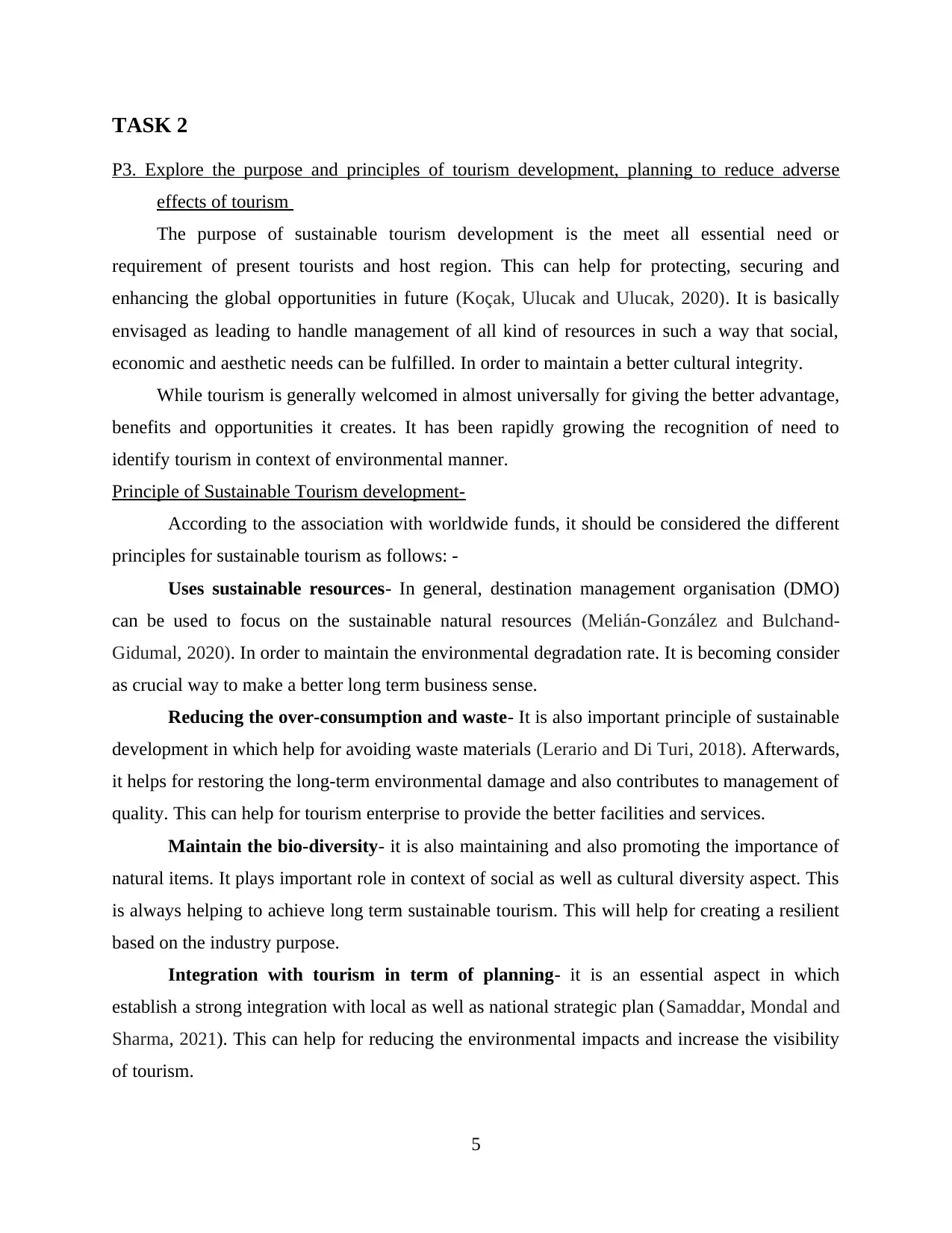
TASK 2
P3. Explore the purpose and principles of tourism development, planning to reduce adverse
effects of tourism
The purpose of sustainable tourism development is the meet all essential need or
requirement of present tourists and host region. This can help for protecting, securing and
enhancing the global opportunities in future (Koçak, Ulucak and Ulucak, 2020). It is basically
envisaged as leading to handle management of all kind of resources in such a way that social,
economic and aesthetic needs can be fulfilled. In order to maintain a better cultural integrity.
While tourism is generally welcomed in almost universally for giving the better advantage,
benefits and opportunities it creates. It has been rapidly growing the recognition of need to
identify tourism in context of environmental manner.
Principle of Sustainable Tourism development-
According to the association with worldwide funds, it should be considered the different
principles for sustainable tourism as follows: -
Uses sustainable resources- In general, destination management organisation (DMO)
can be used to focus on the sustainable natural resources (Melián-González and Bulchand-
Gidumal, 2020). In order to maintain the environmental degradation rate. It is becoming consider
as crucial way to make a better long term business sense.
Reducing the over-consumption and waste- It is also important principle of sustainable
development in which help for avoiding waste materials (Lerario and Di Turi, 2018). Afterwards,
it helps for restoring the long-term environmental damage and also contributes to management of
quality. This can help for tourism enterprise to provide the better facilities and services.
Maintain the bio-diversity- it is also maintaining and also promoting the importance of
natural items. It plays important role in context of social as well as cultural diversity aspect. This
is always helping to achieve long term sustainable tourism. This will help for creating a resilient
based on the industry purpose.
Integration with tourism in term of planning- it is an essential aspect in which
establish a strong integration with local as well as national strategic plan (Samaddar, Mondal and
Sharma, 2021). This can help for reducing the environmental impacts and increase the visibility
of tourism.
5
P3. Explore the purpose and principles of tourism development, planning to reduce adverse
effects of tourism
The purpose of sustainable tourism development is the meet all essential need or
requirement of present tourists and host region. This can help for protecting, securing and
enhancing the global opportunities in future (Koçak, Ulucak and Ulucak, 2020). It is basically
envisaged as leading to handle management of all kind of resources in such a way that social,
economic and aesthetic needs can be fulfilled. In order to maintain a better cultural integrity.
While tourism is generally welcomed in almost universally for giving the better advantage,
benefits and opportunities it creates. It has been rapidly growing the recognition of need to
identify tourism in context of environmental manner.
Principle of Sustainable Tourism development-
According to the association with worldwide funds, it should be considered the different
principles for sustainable tourism as follows: -
Uses sustainable resources- In general, destination management organisation (DMO)
can be used to focus on the sustainable natural resources (Melián-González and Bulchand-
Gidumal, 2020). In order to maintain the environmental degradation rate. It is becoming consider
as crucial way to make a better long term business sense.
Reducing the over-consumption and waste- It is also important principle of sustainable
development in which help for avoiding waste materials (Lerario and Di Turi, 2018). Afterwards,
it helps for restoring the long-term environmental damage and also contributes to management of
quality. This can help for tourism enterprise to provide the better facilities and services.
Maintain the bio-diversity- it is also maintaining and also promoting the importance of
natural items. It plays important role in context of social as well as cultural diversity aspect. This
is always helping to achieve long term sustainable tourism. This will help for creating a resilient
based on the industry purpose.
Integration with tourism in term of planning- it is an essential aspect in which
establish a strong integration with local as well as national strategic plan (Samaddar, Mondal and
Sharma, 2021). This can help for reducing the environmental impacts and increase the visibility
of tourism.
5
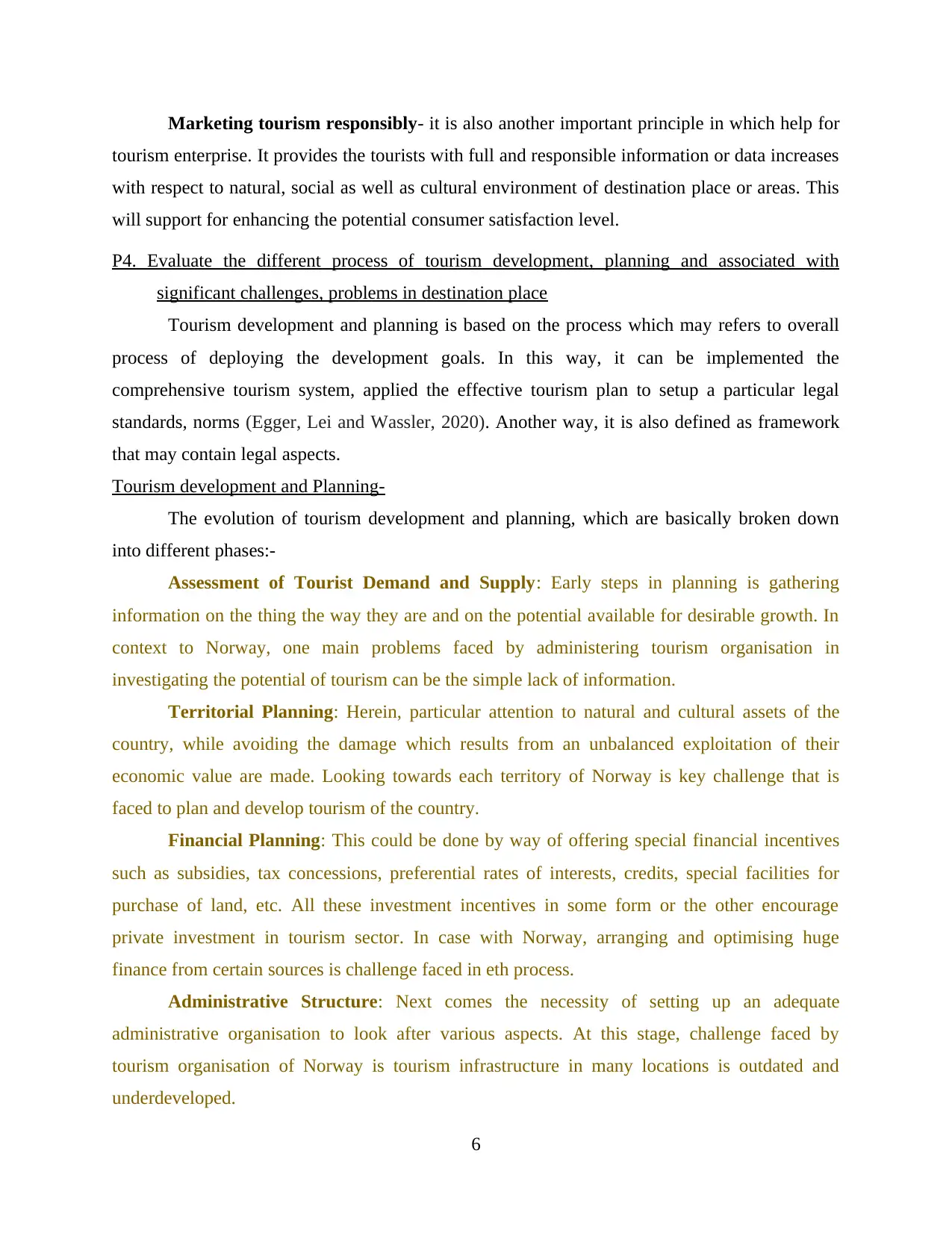
Marketing tourism responsibly- it is also another important principle in which help for
tourism enterprise. It provides the tourists with full and responsible information or data increases
with respect to natural, social as well as cultural environment of destination place or areas. This
will support for enhancing the potential consumer satisfaction level.
P4. Evaluate the different process of tourism development, planning and associated with
significant challenges, problems in destination place
Tourism development and planning is based on the process which may refers to overall
process of deploying the development goals. In this way, it can be implemented the
comprehensive tourism system, applied the effective tourism plan to setup a particular legal
standards, norms (Egger, Lei and Wassler, 2020). Another way, it is also defined as framework
that may contain legal aspects.
Tourism development and Planning-
The evolution of tourism development and planning, which are basically broken down
into different phases:-
Assessment of Tourist Demand and Supply: Early steps in planning is gathering
information on the thing the way they are and on the potential available for desirable growth. In
context to Norway, one main problems faced by administering tourism organisation in
investigating the potential of tourism can be the simple lack of information.
Territorial Planning: Herein, particular attention to natural and cultural assets of the
country, while avoiding the damage which results from an unbalanced exploitation of their
economic value are made. Looking towards each territory of Norway is key challenge that is
faced to plan and develop tourism of the country.
Financial Planning: This could be done by way of offering special financial incentives
such as subsidies, tax concessions, preferential rates of interests, credits, special facilities for
purchase of land, etc. All these investment incentives in some form or the other encourage
private investment in tourism sector. In case with Norway, arranging and optimising huge
finance from certain sources is challenge faced in eth process.
Administrative Structure: Next comes the necessity of setting up an adequate
administrative organisation to look after various aspects. At this stage, challenge faced by
tourism organisation of Norway is tourism infrastructure in many locations is outdated and
underdeveloped.
6
tourism enterprise. It provides the tourists with full and responsible information or data increases
with respect to natural, social as well as cultural environment of destination place or areas. This
will support for enhancing the potential consumer satisfaction level.
P4. Evaluate the different process of tourism development, planning and associated with
significant challenges, problems in destination place
Tourism development and planning is based on the process which may refers to overall
process of deploying the development goals. In this way, it can be implemented the
comprehensive tourism system, applied the effective tourism plan to setup a particular legal
standards, norms (Egger, Lei and Wassler, 2020). Another way, it is also defined as framework
that may contain legal aspects.
Tourism development and Planning-
The evolution of tourism development and planning, which are basically broken down
into different phases:-
Assessment of Tourist Demand and Supply: Early steps in planning is gathering
information on the thing the way they are and on the potential available for desirable growth. In
context to Norway, one main problems faced by administering tourism organisation in
investigating the potential of tourism can be the simple lack of information.
Territorial Planning: Herein, particular attention to natural and cultural assets of the
country, while avoiding the damage which results from an unbalanced exploitation of their
economic value are made. Looking towards each territory of Norway is key challenge that is
faced to plan and develop tourism of the country.
Financial Planning: This could be done by way of offering special financial incentives
such as subsidies, tax concessions, preferential rates of interests, credits, special facilities for
purchase of land, etc. All these investment incentives in some form or the other encourage
private investment in tourism sector. In case with Norway, arranging and optimising huge
finance from certain sources is challenge faced in eth process.
Administrative Structure: Next comes the necessity of setting up an adequate
administrative organisation to look after various aspects. At this stage, challenge faced by
tourism organisation of Norway is tourism infrastructure in many locations is outdated and
underdeveloped.
6
⊘ This is a preview!⊘
Do you want full access?
Subscribe today to unlock all pages.

Trusted by 1+ million students worldwide

Marketing and Promotion: The final stage of the plan is concerned with the preparation
of promotional activities aimed at launching the new tourist industry both within and outside the
country that is Norway. In this, key challenge faced is setting effective promotional strategy as
there are huge number of promotional platforms available that deepens complexities for planning
and developing tourism of Norway.
Monitoring Progress: Monitoring the progress periodically is very crucial to get the best
results. In case with planning and developing tourism of Norway, challenge faced is gasp in
technical knowledge, inefficient practices to monitor and evaluate.
Unplanned Tourism development Era- in this process, it is basically identified the
uncommon things in the tourism development (Dimitriou, 2017). Afterwards, it has been
made a plan to emerge with unplanned activities. In this, possible challenge that is
associated with Norway is recognising things to develop tourism for the location. Positive
impact of the stage is that it assist professionals to look in depth towards areas of
development. However, negative impacts is that it consumes huge time and efforts in
identification of the uncommon things and making plans for improvement.
Starting the partly supplied oriented tourism planning- this type of phase will support
for designing an infrastructure such as restaurants, hotels and other transportation etc.
Challenge associated with the stage of tourism development and planning at Norway is
preparing an effective infrastructure for business concerns. Positive impact of the stage is
that it improves aspects for hospitality companies. In contrary, negative impact is that
when infrastructure is not properly developed then various businesses have to face
complexities to manage ventures.
Market, demand-oriented tourism development- at this phase, it is basically focused
on the gathering, collecting information about different tourists. In order to satisfy all
specific need or demand of consumers. Potential complexity faced in development and
planning of tourism in Norway at this stage is collecting data in proper manner as
respondents fails to give adequate answers and use of some sources becomes unreliable.
At the time, when desires information is collected than further working are carried out
effectively that impacts positively on the process. However, data collection is not an easy
7
of promotional activities aimed at launching the new tourist industry both within and outside the
country that is Norway. In this, key challenge faced is setting effective promotional strategy as
there are huge number of promotional platforms available that deepens complexities for planning
and developing tourism of Norway.
Monitoring Progress: Monitoring the progress periodically is very crucial to get the best
results. In case with planning and developing tourism of Norway, challenge faced is gasp in
technical knowledge, inefficient practices to monitor and evaluate.
Unplanned Tourism development Era- in this process, it is basically identified the
uncommon things in the tourism development (Dimitriou, 2017). Afterwards, it has been
made a plan to emerge with unplanned activities. In this, possible challenge that is
associated with Norway is recognising things to develop tourism for the location. Positive
impact of the stage is that it assist professionals to look in depth towards areas of
development. However, negative impacts is that it consumes huge time and efforts in
identification of the uncommon things and making plans for improvement.
Starting the partly supplied oriented tourism planning- this type of phase will support
for designing an infrastructure such as restaurants, hotels and other transportation etc.
Challenge associated with the stage of tourism development and planning at Norway is
preparing an effective infrastructure for business concerns. Positive impact of the stage is
that it improves aspects for hospitality companies. In contrary, negative impact is that
when infrastructure is not properly developed then various businesses have to face
complexities to manage ventures.
Market, demand-oriented tourism development- at this phase, it is basically focused
on the gathering, collecting information about different tourists. In order to satisfy all
specific need or demand of consumers. Potential complexity faced in development and
planning of tourism in Norway at this stage is collecting data in proper manner as
respondents fails to give adequate answers and use of some sources becomes unreliable.
At the time, when desires information is collected than further working are carried out
effectively that impacts positively on the process. However, data collection is not an easy
7
Paraphrase This Document
Need a fresh take? Get an instant paraphrase of this document with our AI Paraphraser
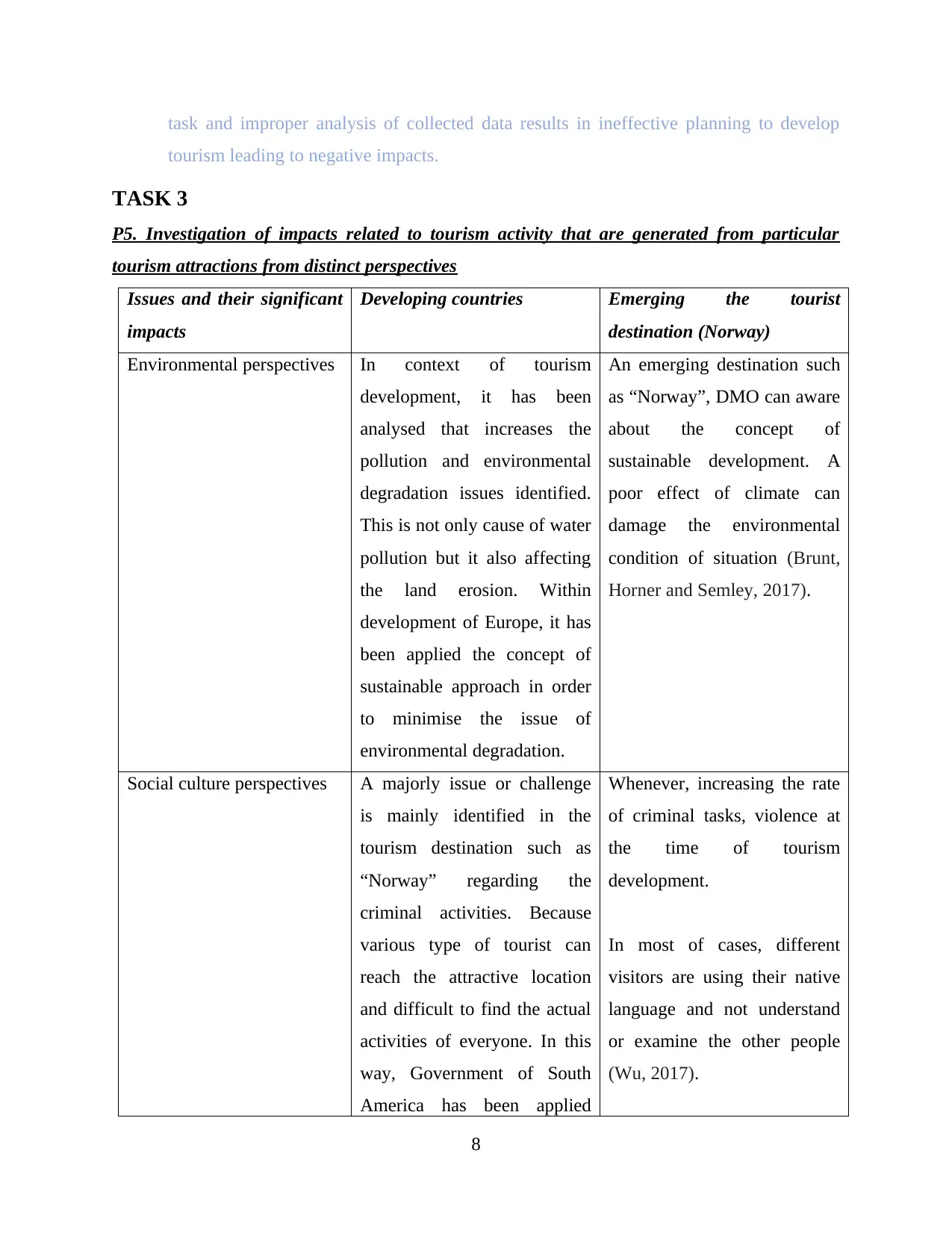
task and improper analysis of collected data results in ineffective planning to develop
tourism leading to negative impacts.
TASK 3
P5. Investigation of impacts related to tourism activity that are generated from particular
tourism attractions from distinct perspectives
Issues and their significant
impacts
Developing countries Emerging the tourist
destination (Norway)
Environmental perspectives In context of tourism
development, it has been
analysed that increases the
pollution and environmental
degradation issues identified.
This is not only cause of water
pollution but it also affecting
the land erosion. Within
development of Europe, it has
been applied the concept of
sustainable approach in order
to minimise the issue of
environmental degradation.
An emerging destination such
as “Norway”, DMO can aware
about the concept of
sustainable development. A
poor effect of climate can
damage the environmental
condition of situation (Brunt,
Horner and Semley, 2017).
Social culture perspectives A majorly issue or challenge
is mainly identified in the
tourism destination such as
“Norway” regarding the
criminal activities. Because
various type of tourist can
reach the attractive location
and difficult to find the actual
activities of everyone. In this
way, Government of South
America has been applied
Whenever, increasing the rate
of criminal tasks, violence at
the time of tourism
development.
In most of cases, different
visitors are using their native
language and not understand
or examine the other people
(Wu, 2017).
8
tourism leading to negative impacts.
TASK 3
P5. Investigation of impacts related to tourism activity that are generated from particular
tourism attractions from distinct perspectives
Issues and their significant
impacts
Developing countries Emerging the tourist
destination (Norway)
Environmental perspectives In context of tourism
development, it has been
analysed that increases the
pollution and environmental
degradation issues identified.
This is not only cause of water
pollution but it also affecting
the land erosion. Within
development of Europe, it has
been applied the concept of
sustainable approach in order
to minimise the issue of
environmental degradation.
An emerging destination such
as “Norway”, DMO can aware
about the concept of
sustainable development. A
poor effect of climate can
damage the environmental
condition of situation (Brunt,
Horner and Semley, 2017).
Social culture perspectives A majorly issue or challenge
is mainly identified in the
tourism destination such as
“Norway” regarding the
criminal activities. Because
various type of tourist can
reach the attractive location
and difficult to find the actual
activities of everyone. In this
way, Government of South
America has been applied
Whenever, increasing the rate
of criminal tasks, violence at
the time of tourism
development.
In most of cases, different
visitors are using their native
language and not understand
or examine the other people
(Wu, 2017).
8
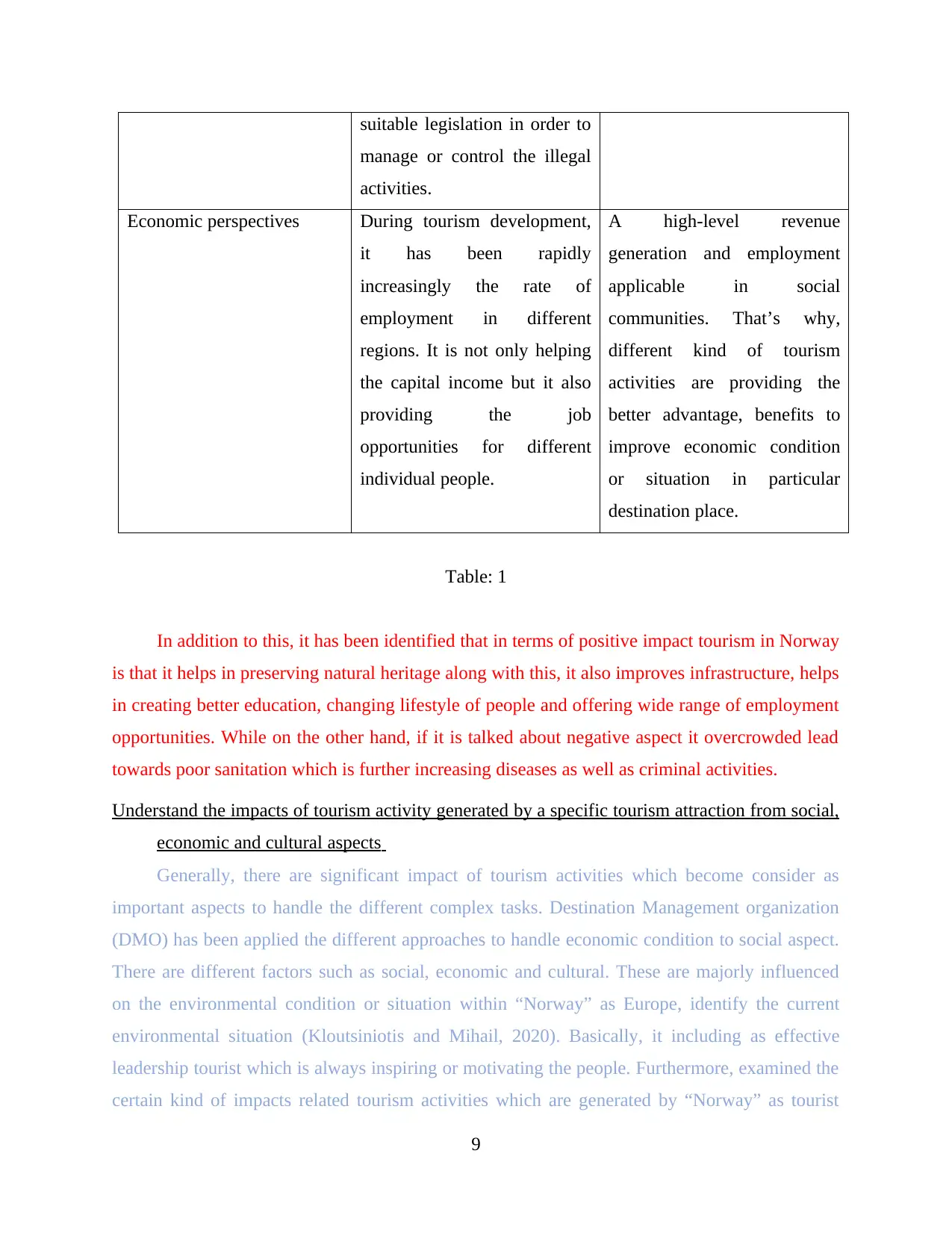
suitable legislation in order to
manage or control the illegal
activities.
Economic perspectives During tourism development,
it has been rapidly
increasingly the rate of
employment in different
regions. It is not only helping
the capital income but it also
providing the job
opportunities for different
individual people.
A high-level revenue
generation and employment
applicable in social
communities. That’s why,
different kind of tourism
activities are providing the
better advantage, benefits to
improve economic condition
or situation in particular
destination place.
Table: 1
In addition to this, it has been identified that in terms of positive impact tourism in Norway
is that it helps in preserving natural heritage along with this, it also improves infrastructure, helps
in creating better education, changing lifestyle of people and offering wide range of employment
opportunities. While on the other hand, if it is talked about negative aspect it overcrowded lead
towards poor sanitation which is further increasing diseases as well as criminal activities.
Understand the impacts of tourism activity generated by a specific tourism attraction from social,
economic and cultural aspects
Generally, there are significant impact of tourism activities which become consider as
important aspects to handle the different complex tasks. Destination Management organization
(DMO) has been applied the different approaches to handle economic condition to social aspect.
There are different factors such as social, economic and cultural. These are majorly influenced
on the environmental condition or situation within “Norway” as Europe, identify the current
environmental situation (Kloutsiniotis and Mihail, 2020). Basically, it including as effective
leadership tourist which is always inspiring or motivating the people. Furthermore, examined the
certain kind of impacts related tourism activities which are generated by “Norway” as tourist
9
manage or control the illegal
activities.
Economic perspectives During tourism development,
it has been rapidly
increasingly the rate of
employment in different
regions. It is not only helping
the capital income but it also
providing the job
opportunities for different
individual people.
A high-level revenue
generation and employment
applicable in social
communities. That’s why,
different kind of tourism
activities are providing the
better advantage, benefits to
improve economic condition
or situation in particular
destination place.
Table: 1
In addition to this, it has been identified that in terms of positive impact tourism in Norway
is that it helps in preserving natural heritage along with this, it also improves infrastructure, helps
in creating better education, changing lifestyle of people and offering wide range of employment
opportunities. While on the other hand, if it is talked about negative aspect it overcrowded lead
towards poor sanitation which is further increasing diseases as well as criminal activities.
Understand the impacts of tourism activity generated by a specific tourism attraction from social,
economic and cultural aspects
Generally, there are significant impact of tourism activities which become consider as
important aspects to handle the different complex tasks. Destination Management organization
(DMO) has been applied the different approaches to handle economic condition to social aspect.
There are different factors such as social, economic and cultural. These are majorly influenced
on the environmental condition or situation within “Norway” as Europe, identify the current
environmental situation (Kloutsiniotis and Mihail, 2020). Basically, it including as effective
leadership tourist which is always inspiring or motivating the people. Furthermore, examined the
certain kind of impacts related tourism activities which are generated by “Norway” as tourist
9
⊘ This is a preview!⊘
Do you want full access?
Subscribe today to unlock all pages.

Trusted by 1+ million students worldwide
1 out of 20
Related Documents
Your All-in-One AI-Powered Toolkit for Academic Success.
+13062052269
info@desklib.com
Available 24*7 on WhatsApp / Email
![[object Object]](/_next/static/media/star-bottom.7253800d.svg)
Unlock your academic potential
Copyright © 2020–2025 A2Z Services. All Rights Reserved. Developed and managed by ZUCOL.





